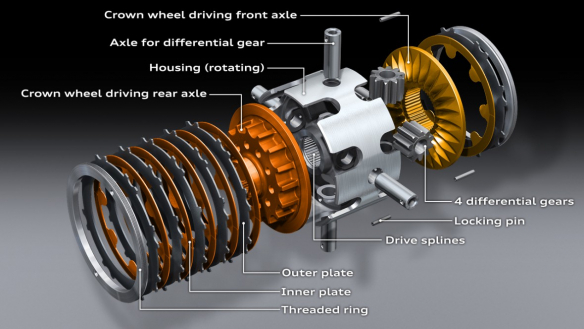Crown gear differential
Exactly 30 years after the debut of the first quattro, Audi introduced the latest evolutionary stage of its permanent all-wheel drive system for longitudinal front-mounted engines – quattro drive with crown gear differential and torque vectoring.
Inside the new center differential, which made its debut in the RS 5 in early 2010, are two crown gears that owe their name to the crown-like geometry of their teeth. The rear crown gear drives the prop shaft to the rear-axle differential while the front crown gear drives the output shaft to the front-axle differential. The crown gears mesh with four rotatable pinion gears. They are arranged at right angles to one another and are driven by the differential’s housing, i.e. by the transmission output shaft.
Under normal driving conditions, the two crown gears rotate at the same speed as the housing. Their special geometry results in intentionally disproportionate leveraging: normally, 60 percent of engine torque is funneled to the rear axle and 40 percent to the front.
If a shift in torque occurs due to a loss of grip at one axle, different speeds and axial forces develop within the differential, and the adjacent plate packages are forced together. The resulting self-locking effect now diverts the majority of the torque to the axle with the better traction; up to 85 percent flows to the rear. In the opposite scenario – if the rear axle has less grip – the same happens in reverse; now up to 70 percent of the torque is diverted to the front axle.
Thanks to this even wider range of torque distribution, the crown gear differential surpasses its predecessors to facilitate even better traction. Forces and torques are redistributed utterly consistently and without delay. The mechanical operating principle guarantees maximum efficiency and instantaneous responsiveness. Other strong points of the crown gear differential are its compactness and low weight – at 4.8 kilograms (10.58 lb), it is roughly two kilograms (4.41 lb) lighter than the previous component.
Audi couples the crown gear differential with an intelligent brake management software solution called torque vectoring, which can act on each of the four wheels separately. This new system makes cornering even more precise and dynamic.
When cornering at speed, the software uses the driver’s steering input and desired level of acceleration to calculate the optimal distribution of propulsive power between all four wheels. If it detects that the wheels on the inside of the curve, which are under a reduced load, will soon begin to slip, it marginally brakes these wheels – just slight application of the pads on the disks at minimal pressure is all that it takes.
The action of the differential gives the outside wheels braking torque to “lean” on, thus allowing them to transmit more torque to the road. This assistance is provided smoothly and continuously. The car remains neutral noticeably longer; understeer while turning and accelerating is practically eliminated. Last but not least, the ESP intervenes later and more gently – if any intervention at all is necessary.
Status: 2011
